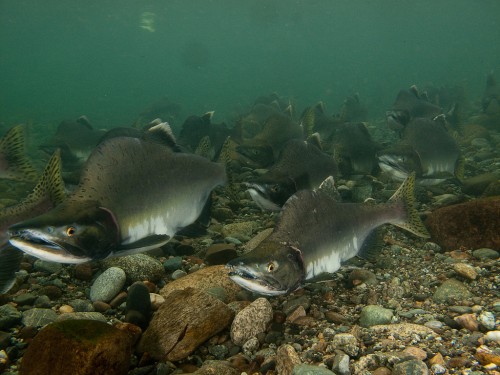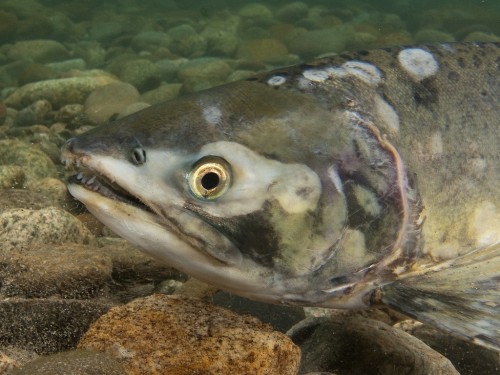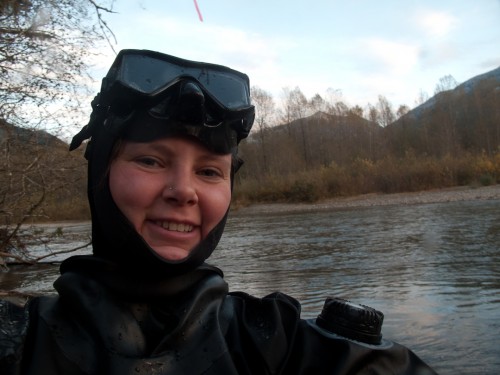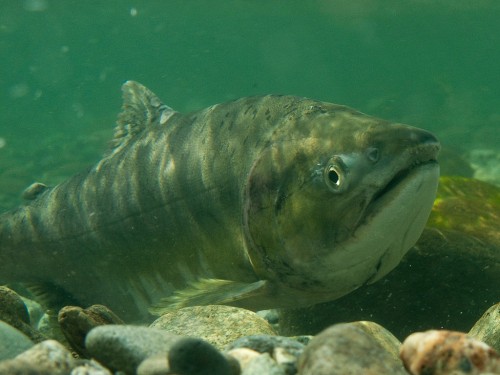Swimming with the Salmon

“I think we’re going to the moon because it’s in the nature of the human being to face challenges. It’s by the nature of his deep inner soul… we’re required to do these things just as salmon swim upstream.” ~ Neil Armstrong
In the fall, the Skagit River is flooded with dying salmon. I have spent three weekends in the past two months trying to capture the essence of these amazing creatures on camera. I am still not sure whether I succeeded in doing so, but I am happy to share my experiences.
Hanging out with snorkeling gear in 36-degree water probably isn’t everybody’s favorite thing to do, but since I moved up to the Environmental Learning Center, it has become my preferred hobby. The place I like to go is the Cascade River just upstream of where it enters the Skagit. When the salmon are running, you know where to find me!
There’s something extraordinary about being amongst these primordial beings and watching them in their natural habitat. It’s like I get to peer in through a secret window into the lives of one of nature’s wildest creatures. While watching the fish swarm around me and make their redds, defend their territory, court a mate, or just plain get feisty with each other, I begin to understand a little more of the complexity of this species. I don’t know their whole story, but I try to imagine all they have been through. Seeing their scars and bacteria loaded scales gives me a clue.
 A dying, diseased female humpy on the final legs of her journey back to her native spawning grounds.
A dying, diseased female humpy on the final legs of her journey back to her native spawning grounds.
We are fortunate to have all five species of salmon in the Skagit River watershed, and I have been lucky enough to be able to spend some time this fall with the pink salmon, also known as humpies. By the time I interact with these creatures, they have traveled 70 miles from the Salish Sea, up the Skagit, and into the Cascades River. Along their journey they must fight off disease, dodge fishhooks, and escape from predators. When they finally reach their native spawning grounds, they barely have enough life left in them to reproduce before they die.
The thing that fascinates me the most about these fish is the interconnectedness of their life histories to the health of the ecosystem. Dana Vasali, a naturalist from the Methow Valley, told our graduate cohort during our Fall Grad Retreat that if it was not for the dying salmon whose carcasses cycle the nutrients back upstream, the only life would be in the oceans. This makes sense to me. The mountains are constantly eroding away and heading downriver towards the Puget Sound, taking nutrients and minerals with them. Thanks to the Skagit River and its fish-filled waters, the nutrients are cycled back into the mountains ecosystem.
All along the lower tributaries which feed into the Skagit River watershed, the smell of decaying fish cannot be missed. I have to admit, I have grown to love it. Salmon carcasses laid to rest and washed up on shore, picked apart by scavengers and other predators. The pieces that are left decompose and reinvigorate the river shorelines and vegetative communities with a new supply of nutrients needed for a healthy habitat. Other members of the ecosystem also help with this process. Whether it’s a bear snagging salmon from the river and taking their bodies up into the woods, or a bald eagle flying high dropping a salmon or two into the trees, salmon bodies play an important role in cycling nutrients through the ecosystem.
 Me clad in drysuit and snorkeling gear in the freezing waters of Cascade River.
Me clad in drysuit and snorkeling gear in the freezing waters of Cascade River.
Spending some quality time with these fish is well worth the trouble, the cold, and the weird looks from fishermen nearby. When trying to take pictures of fish, it is necessary to wade for long periods of time in the water. This can get very cold very fast, even through a wet suit and layers and layers of undergarments. But this also means there is much more time to witness their behavior and let them get to know you. In September and October, I witnessed the humpies running and, during my last snorkeling excursion in November, I spent some time with the coho who were astonishingly big and beautiful creatures as well. But my most memorable encounter happened with a pink salmon last month, an experience I will never forget for the rest of my life.
 The female humpy as she gets ready for another belly rub against my hand.
The female humpy as she gets ready for another belly rub against my hand.
After waiting patiently for some time in the Cascade River, I noticed a female humpy becoming very comfortable with me. It wasn’t long before I could put out my hand and she would brush against it, positioning herself each time for a nice belly rub. Seeing her scars close up, feeling her weak muscles pulsating against my glove, and looking her in the eye brought tears to my eye. I couldn’t imagine all she had been through and wished I knew her story. I had a serious moment with a fish!
I plan to continue hanging out with salmon throughout the winter when I have some more free time. I am already looking forward to the chum salmon which will start running in late November! My intimate encounters with salmon this fall have inspired in me a deeper appreciation for this wild species. I hope to continue doing what I can through photography and education to bring awareness to the importance of this beautiful creature and their integral role in the health of the Skagit River watershed.
All photos courtesy of the author.


beautiful!
Great post and photos, thanks Jess!
Wow! You’ve almost sold me on this cold water diving idea! Your photos are amazing, and your stories are even better.
Thanks! You have given the salmons and their primordial journey a “personal” face.
Love the article! I snorkel the river of the Wenatchee system and completely understand your fascination with documenting these magical creatures. I posted you writeup on my FB community dedicated to exploring rivers. Come on over and check it out:
https://www.facebook.com/pages/River-Snorkeling/100552343334649
I am absolutely wowed by your photograph of the salmon I saw in the Sunday, Nov. 25th “Reader’s Lens.”
I would love to see more photos. I also would love to
make some drawings from your photos in colored pencil. I would like to give you an original drawing in return for letting me see and draw from one or two of your photos. Some years ago I was the Art Director for Alaska Magazine and we published many photos of spawning salmon in their heroic upstream efforts and I felt the drama, and at the same time, pathos of these beautiful creatures.
Admiringly,
Roz Pape
I didn’t sign with my email address. I would love an answer to my comments.
Roz Pape
rozart3@q.com
Thanks everyone!! And Roz- I sent you an email about a month ago now, did you receive it? Please let me know!
No, I didn’t get your message. Would love to see it.
I’m still so interested in your remarkable photos.
Roz Pape